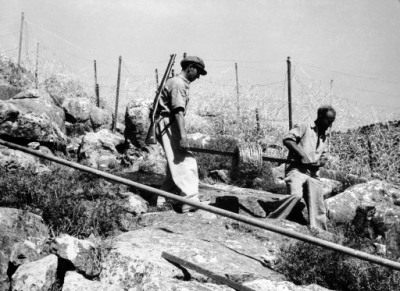Pages in Section 7

Tegart's Wall
ii. The Irgun retaliate
iii. The Army takes over
iv. Tegart's Wall
v. Wyngate's Night Squads
vi. Arabs capture Old City
vii. White Paper
viii. 1939 Jewish Political Scene
 In December 1937 Sir Charles Tegart arrived to assess the situation and give advice. He came with the highest of qualifications. He had joined the Calcutta Police in 1901, and had served there almost continuously, moving up the ranks until he had become Commissioner of the Calcutta Police in 1923. By 1937 he was regarded as the Empire's highest expert on policing unruly areas.
In December 1937 Sir Charles Tegart arrived to assess the situation and give advice. He came with the highest of qualifications. He had joined the Calcutta Police in 1901, and had served there almost continuously, moving up the ranks until he had become Commissioner of the Calcutta Police in 1923. By 1937 he was regarded as the Empire's highest expert on policing unruly areas.
 Sir Charles Tegart advised the Inspector General to construct a Frontier fence along the northern border to control the movement of insurgents, goods and weapons and also to build a line of reinforced concrete police stations and pill boxes. Alan Saunders accepted the recommendations. In his memoirs David Hacohen, a director of the Jewish building firm, Solel Boneh, records a conversation with Tegart, regarding his contract to build the wall.
Sir Charles Tegart advised the Inspector General to construct a Frontier fence along the northern border to control the movement of insurgents, goods and weapons and also to build a line of reinforced concrete police stations and pill boxes. Alan Saunders accepted the recommendations. In his memoirs David Hacohen, a director of the Jewish building firm, Solel Boneh, records a conversation with Tegart, regarding his contract to build the wall.
He warned Tegart that Britain didn't have enough barbed for the project. Tegart, he says, joked that he didn't own shares in British barbed wire companies so Solel Boneh was free to buy it from wherever it was available. Solel Boneh bought it from Mussolini's Italy. The 9ft fence was swiftly erected but even before it was finished rebels had sabotaged a section. The fence impeded legitimate trade and it crossed pastures and private land,so Arab tractors and bulldozers were constantly bringing it down.
 In 1939, when the Arab Revolt was over, the fence was taken down. However,many concrete police stations and pill boxes built alongside the wall remain.
In 1939, when the Arab Revolt was over, the fence was taken down. However,many concrete police stations and pill boxes built alongside the wall remain.
The photo on the left shows a still existing pillbox.
The outbreak of WW 2 temporarily halted the construction of further tegarts inland.
(More about tegarts later in The Final Fortress).